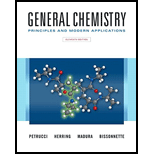
(a)
Interpretation:
Calculate the value of equilibrium constant for dissolution of AgBr which is a sparingly soluble solute with the help of given
Concept introduction:
Sparingly soluble salts form their respective ions in their solutions. The dissolution process is just opposite to the precipitation reaction. The standard free energy change can be calculated with the help of Gibb’s energy for the reactant and products. The mathematical expression of Gibb’s energy can be written as:
Here:
- R = 8.314 J / mol .K
- T = temperature in Kelvin
(b)
Interpretation:
Calculate the value of equilibrium constant for dissolution of
Concept introduction:
Sparingly soluble salts form their respective ions in their solutions. The dissolution process is just opposite to the precipitation reaction. The standard free energy change can be calculated with the help of Gibb’s energy for the reactant and products. The mathematical expression of Gibb’s energy can be written as:
Here:
- R = 8.314 J / mol .K
- T = temperature in Kelvin
(c)
Interpretation:
Calculate the value of equilibrium constant for dissolution of
Concept introduction:
Sparingly soluble salts form their respective ions in their solutions. The dissolution process is just opposite to the precipitation reaction. The standard free energy change can be calculated with the help of Gibb’s energy for the reactant and products. The mathematical expression of Gibb’s energy can be written as:
Here:
- R = 8.314 J / mol .K
- T = temperature in Kelvin
Want to see the full answer?
Check out a sample textbook solution
Chapter 13 Solutions
Generl Chem Looself&mod Mst/et&stdy Crd Pkg, 11/e
- Given that the ΔG°f for Pb2+(aq) and Cl−(aq) is −24.3 kJ/mole and −131.2 kJ/mole respectively, determine the solubility product, Ksp, for PbCl2(s).arrow_forwardWhat would be the KPs value of Al(OH)3, considering that its solubility is 2,5 x 10^-8 mol/L?arrow_forwardUse the data given to estimate the molar solubilities of (a) BaSO4, (b) Ag2CO3, (c) Fe(OH)3, (d) Hg2CI2 in water.arrow_forward
- A buffer solution of volume 100 cm3 consists of 0.10 M CH3COOH(aq) and 0.10 MNaCH3CO2(aq). (a) What is its pH? (b) What is the pH after the addition of 3.3 mmol NaOH to the buffer solution? (c) What is the pH after the addition of 6.0 mmol HNO3 to the initial buffer solution?arrow_forwardThe solubility product for silver chloride is 1.6 x 10−10. What is the molar solubility of silver chloride in a 6.5 x 10−3 M AgNO3 aqueous solution at 298 K?arrow_forwardThe molar solubility of Ag2C2O4 increases when it is dissolved in 0.5 M HClO4 (aq) instead of neutral distilled water. Write a balanced, net-ionic equation for the process that occurs between species in solution that contributes to the increased solubility of Ag2C2O4 (aq) in HClO4 (aq).arrow_forward
- the molar solubility for Fe(oh)3 in an aqueous solution was determined to be 4.0x10^-3 what is the value of ksp?arrow_forwardSolubility of PbCl2 in water is 0.0150 g/L at 25 oC. What is the molar concentration of Cl- ion in the solution at the same temperature?arrow_forwardThe hardness of water (hardness count) is usually expressed in parts per million (by mass) of CaCO3. What is the molar concentration of Ca2+ ions in a water sample with a hardness count of 175mg CaCO3il? How many milliliters of concentrated sulfuric acid, 94.0% (w/w), specific gravity of 1.831 are required to prepare 1 liter of a 0.100 M solution? The solubility-product constant for Ce(IO3)3 is 3.2x1010. What is the Ce3+ concentration in a solution prepared by mixing 50.0 ml of 0.0250 M Ce3.. with 50.00 ml of water?arrow_forward
- The molar solubility of AgCl(s) in water at 25°C is 1.33 x 10−5 M. AgCl(s) ↔ Ag+(aq) + Cl−(aq) What is the molar solubility of AgCl(s) at 50.0°C?arrow_forwardIn nonaqueous solvents, it is possible to react HF to create H2F+. Which of these statements follows from this observation?(a) HF can act like a strong acid in nonaqueoussolvents, (b) HF can act like a base in nonaqueous solvents,(c) HF is thermodynamically unstable, (d) There is an acidin the nonaqueous medium that is a stronger acid than HF.arrow_forwardHow do you find the solubility constant for Al(OH)3, MnS, and Ca3(PO4)2?arrow_forward
 Chemistry & Chemical ReactivityChemistryISBN:9781337399074Author:John C. Kotz, Paul M. Treichel, John Townsend, David TreichelPublisher:Cengage Learning
Chemistry & Chemical ReactivityChemistryISBN:9781337399074Author:John C. Kotz, Paul M. Treichel, John Townsend, David TreichelPublisher:Cengage Learning Chemistry: An Atoms First ApproachChemistryISBN:9781305079243Author:Steven S. Zumdahl, Susan A. ZumdahlPublisher:Cengage Learning
Chemistry: An Atoms First ApproachChemistryISBN:9781305079243Author:Steven S. Zumdahl, Susan A. ZumdahlPublisher:Cengage Learning ChemistryChemistryISBN:9781305957404Author:Steven S. Zumdahl, Susan A. Zumdahl, Donald J. DeCostePublisher:Cengage Learning
ChemistryChemistryISBN:9781305957404Author:Steven S. Zumdahl, Susan A. Zumdahl, Donald J. DeCostePublisher:Cengage Learning



